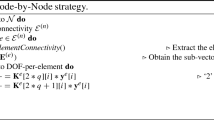Abstract
Finite Difference Time Domain (FDTD) is the most popular method in computational electromagnetics. In acoustics, FDTD is often used as a numerical analysis technique to model mechanical wave and acoustics. FDTD in general is computationally expensive in terms of time due to its large number of time steps for accurate precision and is data parallel in nature. However, it is also memory bounded. Although previous work on FDTD has studied the effect of parallelizing FDTD on accelerators to reduce computational cost, the memory bounded problem has not been studied. In this work we consider the segmented FDTD (SFDTD) algorithm that divides the problem space into segments to reduce computational redundancy and also reduce memory. We exploit the memory hierarchy of the GPU to efficiently implement the SFDTD algorithm. To the best of our knowledge, this is the first work that studies the implementation of the SFDTD algorithm on GPU and its effect on memory.
Access this chapter
Tax calculation will be finalised at checkout
Purchases are for personal use only
Similar content being viewed by others
References
Berenger, J.P.: A perfectly matched layer for the absorption of electromagnetic waves. J. Comput. Phys. 114(2), 185–200 (1994)
Courant, R., Friedrichs, K., Lewy, H.: On the partial difference equations of mathematical physics. IBM J. Res. Dev. 11(2), 215–234 (1967)
Demir, V., Elsherbeni, A.: Utilization of CUDA-OpenGL interoperability to display electromagnetic fields calculated by FDTD. In: Computational Electromagnetics International Workshop (CEM), pp. 95–98 (2011)
Drumm, I.: Implementing the FDTD tutorial. University of Salford - EPSRC Summer School, Salford, UK. http://www.acoustics.salford.ac.uk/res/drumm/FDTD-FE/Implementing%20FDTD%20Tutorial.doc (2007)
Engquist, B., Majda, A.: Absorbing boundary conditions for the numerical simulation of waves. Math. Comput. 31(139), 629–651 (1977)
Herlihy, M.P.: Impossibility and universality results for wait-free synchronization. In: Proceedings of the 7th Annual ACM Symposium on Principles of Distributed Computing, PODC ’88, pp. 276–290. ACM, New York (1988)
Holland, R.: THREDE: a free-field EMP coupling and scattering code. IEEE Trans. Nucl. Sci. 24(6), 2416–2421 (1977)
Ireland, D., Tee, W.C., Bialkowski, M.: Accelerated biomedical simulations using the FDTD method and the CUDA architecture. In: Microwave Conference Proceedings (APMC), 2011 Asia-Pacific, pp. 70–73. IEEE (2011)
Ju, F., Xing, C.: A study of parallel FDTD for simulating complex antennas on a cluster system. In: Microwave Conference Proceedings, 2005. APMC 2005. Asia-Pacific Conference Proceedings, vol. 5, p.4 (2005)
Kirk, D.B., Wen-mei, W.H.: Programming Massively Parallel Processors: A Hands-on Approach. Morgan Kaufmann, Boston (2010)
Kondylis, G.D., De Flaviis, F., Pottie, G.J., Itoh, T.: A memory-efficient formulation of the finite-difference time-domain method for the solution of Maxwell equations. IEEE Trans. Microwave Theor. Tech. 49(7), 1310–1320 (2001)
Kowalczyk, K.: Boundary and medium modelling using compact finite difference schemes in simulations of room acoustics for audio and architectural design applications. Ph.D. thesis, Queen’s University Belfast (2010)
Lindman, E.: Free pace boundary conditions of the time dependent wave equation. J. Comput. Phys. 18(1), 66–78 (1975)
Lipták, B.G.: Instrument Engineers’ Handbook: Process Control and Optimization, vol. 2. CRC Press, Boca Raton (2005)
Livesey, M., Stack, J., Costen, F., Nanri, T., Nakashima, N., Fujino, S.: Development of a CUDA implementation of the 3D FDTD method. IEEE Antennas Propag. Mag. 54(5), 186–195 (2012)
Moore, T., Blaschak, J., Taflove, A., Kriegsmann, G.: Theory and application of radiation boundary operators. IEEE Trans. Antennas Propag. 36(12), 1797–1812 (1988)
Mur, G.: Absorbing boundary conditions for the finite-difference approximation of the time-domain electromagnetic-field equations. IEEE Trans. Electromagn. Compat EMC 23(4), 377–382 (1981)
Nagaoka, T., Watanabe, S.: Accelerating three-dimensional FDTD calculations on GPU clusters for electromagnetic field simulation. In: 2012 Annual International Conference of the IEEE Engineering in Medicine and Biology Society (EMBC), pp. 5691–5694 (2012)
Schroeder, M., Rossing, T.D., Dunn, F., Hartmann, W.M., Campbell, D.M., Fletcher, N.H.: Springer Handbook of Acoustics, 1st edn. Springer, New York (2007)
Taflove, A.: Application of the finite-difference time-domain method to sinusoidal steady-state electromagnetic-penetration problems. IEEE Trans. Electromagn. Compat EMC 22(3), 191–202 (1980)
Unno, M., Aono, S., Asai, H.: GPU-based massively parallel 3-D HIE-FDTD method for high-speed electromagnetic field simulation. IEEE Trans. Electromagn. Compat. 54(4), 912–921 (2012)
Wu, Y., Lin, M., Wassell, I.: Path loss estimation in 3D environments using a modified 2D finite-difference time-domain technique. In: 2008 IET 7th International Conference on Computation in Electromagnetics, CEM 2008, pp. 98–99 (2008)
Wu, Y., Wassell, I.: Introduction to the segmented finite-difference time-domain method. IEEE Trans. Magn. 45(3), 1364–1367 (2009)
Xu, M., Thulasiraman, P., Noghanian, S.: Microwave tomography for breast cancer detection on cell broadband engine processors. J. Parallel Distrib. Comput. 72(9), 1106–1116 (2012)
Yee, K.: Numerical solution of initial boundary value problems involving Maxwell’s equations in isotropic media. IEEE Trans. Antennas Propag. 14(3), 302–307 (1966)
Yu, W., Liu, Y., Su, Z., Hunag, N.T., Mittra, R.: A robust parallel conformal finite-difference time-domain processing package using the MPI library. IEEE Antennas Propag. Mag. 47(3), 39–59 (2005)
Yuan, X., Borup, D., Wiskin, J., Berggren, M., Eidens, R., Johnson, S.: Formulation and validation of Berenger’s PML absorbing boundary for the FDTD simulation of acoustic scattering. IEEE Trans. Ultrason. Ferroelectr. Freq. Control 44(4), 816–822 (1997)
Zhang, C., Qin, Y., Zhao, G., Zhu, Y.: Two-dimensional FDTD simulation for the acoustic propagation in a piezoelectric superlattice. In: 2009 IEEE International Ultrasonics Symposium (IUS), pp. 2031–2032 (2009)
Author information
Authors and Affiliations
Corresponding author
Editor information
Editors and Affiliations
Rights and permissions
Copyright information
© 2014 Springer-Verlag Berlin Heidelberg
About this paper
Cite this paper
Chan, J.J.M., Battoo, G., Thulasiraman, P., Thulasiram, R.K. (2014). Effects of Segmented Finite Difference Time Domain on GPU. In: Wyrzykowski, R., Dongarra, J., Karczewski, K., Waśniewski, J. (eds) Parallel Processing and Applied Mathematics. PPAM 2013. Lecture Notes in Computer Science(), vol 8385. Springer, Berlin, Heidelberg. https://doi.org/10.1007/978-3-642-55195-6_12
Download citation
DOI: https://doi.org/10.1007/978-3-642-55195-6_12
Published:
Publisher Name: Springer, Berlin, Heidelberg
Print ISBN: 978-3-642-55194-9
Online ISBN: 978-3-642-55195-6
eBook Packages: Computer ScienceComputer Science (R0)




